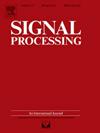LFMCW雷达振动测量的频相耦合参数估计
IF 3.4
2区 工程技术
Q2 ENGINEERING, ELECTRICAL & ELECTRONIC
引用次数: 0
摘要
线性调频连续波(LFMCW)雷达在振动测量中有着广泛的应用。在接收到的中频信号中,距离信息同时嵌入在频率和相位中,即频相耦合。早期的研究主要依靠经典的相位展开算法,这些算法在快速或大振幅振动时经常失败。尽管最近的进展通过将频率衍生的粗距离估计作为相位展开的侧信息来增强鲁棒性,但这些顺序方法仍然没有充分利用固有的频率-相位耦合关系。在本文中,我们提出了一种联合利用频率和相位信息进行直接距离估计的新方法。首先,我们推导了一个简化的离散基带信号模型,它清楚地揭示了耦合。最大似然(ML)估计用于获得所承诺的性能,但其复杂性随着观测量的增加呈指数增长。为了克服复杂性障碍,我们提出了一种启发式方法来顺序求解这种联合优化问题,其性能接近cram本文章由计算机程序翻译,如有差异,请以英文原文为准。
Frequency–phase coupled parameter estimation for vibration measurement with LFMCW radar
Linear frequency modulated continuous wave (LFMCW) radar is widely employed in vibration measurement. In the received intermediate frequency signal, the distance information is embedded in both the frequency and phase, i.e., frequency–phase coupling. Early studies rely primarily on classical phase unwrapping algorithms, which frequently fail during rapid or large-amplitude vibrations. Although recent advances have enhanced robustness by incorporating frequency-derived coarse distance estimates as side information for phase unwrapping, these sequential approaches still under-utilize the inherent frequency–phase coupling relationship. In this article, we propose a novel method that jointly leverages both frequency and phase information for direct distance estimation. To start with, we derive a simplified discrete-time baseband signal model, which clearly unveils the coupling. The maximum likelihood (ML) estimation is used to reap the promised performance, but its complexity grows exponentially with the number of observations. To address the complexity barrier, we propose a heuristic method to sequentially solve such a joint optimization problem, and the performance is close to the Cramér–Rao lower bound (CRLB). We analyze the behavior of the ML estimators and discuss the impact of various parameters on system performance. A real-world experiment validates the system model and the proposed algorithm, with results aligning with theoretical analysis.
求助全文
通过发布文献求助,成功后即可免费获取论文全文。
去求助
来源期刊

Signal Processing
工程技术-工程:电子与电气
CiteScore
9.20
自引率
9.10%
发文量
309
审稿时长
41 days
期刊介绍:
Signal Processing incorporates all aspects of the theory and practice of signal processing. It features original research work, tutorial and review articles, and accounts of practical developments. It is intended for a rapid dissemination of knowledge and experience to engineers and scientists working in the research, development or practical application of signal processing.
Subject areas covered by the journal include: Signal Theory; Stochastic Processes; Detection and Estimation; Spectral Analysis; Filtering; Signal Processing Systems; Software Developments; Image Processing; Pattern Recognition; Optical Signal Processing; Digital Signal Processing; Multi-dimensional Signal Processing; Communication Signal Processing; Biomedical Signal Processing; Geophysical and Astrophysical Signal Processing; Earth Resources Signal Processing; Acoustic and Vibration Signal Processing; Data Processing; Remote Sensing; Signal Processing Technology; Radar Signal Processing; Sonar Signal Processing; Industrial Applications; New Applications.
 求助内容:
求助内容: 应助结果提醒方式:
应助结果提醒方式:


